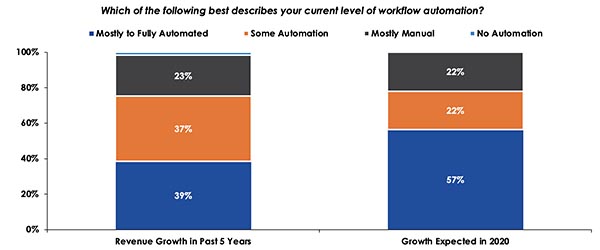- Nearly a third of European PSPs and 55% of North American PSPs reported that dealing with a high number of small jobs is a primary challenge for their current workflow.
- For the first time in the past three years, more PSPs were “mostly automated” rather than reporting lower levels or no automation in their workflows. This increase is likely due to multi-year digital transformation initiatives that were accelerated during the pandemic.
- According to Keypoint Intelligence’s research, companies that were experiencing revenue growth also reported the highest levels of workflow automation.
By Ryan McAbee
Introduction
Ongoing changes in the printing industry continue to stress production processes and workflows. The increase in digitally driven on-demand printing, combined with the flexibility of online ordering, has greatly increased the number of print orders—often at lower print volumes—that a print service provider (PSP) must manage and produce. According to Keypoint Intelligence’s research, the average number of monthly print orders surpassed 3,500 for European PSPs in 2020, which equates to 117 per day. Nearly a third of European PSPs and 55% of North American PSPs reported that dealing with a high number of small jobs is a primary challenge for their current workflow.
Automation Accelerated in 2020
In previous years, PSPs sought to reduce costs and improve efficiencies (which also requires a focus on workflow automation). In 2020, roughly 60% of EU and NA printers saw cost reduction and efficiency as a key component of their business strategy. Efforts to control costs while improving automation have increased since the start of the pandemic.
For the first time in the past three years, more PSPs were “mostly automated” rather than reporting lower levels or no automation in their workflows. This increase is likely due to multi-year digital transformation initiatives that were accelerated during the pandemic. Companies suddenly found time for their employees to focus on neglected projects rather than daily production demands. The largest shift appears to have been from PSPs who previously reported “some automation,” completed transformation projects, and now consider themselves “mostly automated.”
Automation Enables Growth
When we looked at European PSPs that reported growth over the past five years as well as those that expected growth at the end of 2020, we found that automation matters. In both timeframes, companies that were experiencing revenue growth also reported the highest levels of workflow automation. Simply put, more automation correlates to a higher potential for growth.
Figure 1. Automation Level of Companies with Revenue Growth

N = 250 Respondents
Source: European Software Investment Outlook, Keypoint Intelligence 2021
Automation can take many forms and span many processes and departments. Workflow assessments and research by Keypoint Intelligence have shown that improving job onboarding processes and leveraging optimization techniques in prepress can have positive financial impacts. Capturing the customer request and content are the two primary tasks to onboard a print job that should be structured and digitized, perhaps through an online request for quote tool or web-to-print solution. As for optimization, improving the composition and quality of files, in addition to using ink optimization software, provides annual savings in consumables and labor costs.
The Bottom Line
The increased levels of automation are a positive indicator that some PSPs will be ready for the next shift in automation that enables smart print manufacturing. There is a progressive order before PSPs can reach semi- to fully autonomous printing by the end of this decade. First, the right processes must be streamlined to the minimal amount required to do the work. Second, any process that can be automated should be. Third, advanced technologies must be applied when available to bring intelligence (augmented and artificial) across the entire print manufacturing ecosystem and value chain.
PSPs that increase their levels of automation now are likely to reap disproportionate rewards in the future. This is because reaching the finish line requires thousands of incremental steps; true automation simply cannot be achieved in one giant leap.
Ryan McAbee is a Director for Keypoint Intelligence’s Production Workflow Consulting Service, which focuses on providing technology, business, and market insights to clients in the Digital Marketing & Media and Production Workflow markets. In this role, he is responsible for conducting market research, market analysis and forecasting, content development, industry training, and consulting with print service providers.










Discussion
Join the discussion Sign In or Become a Member, doing so is simple and free